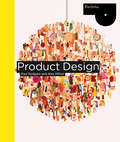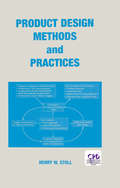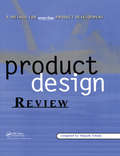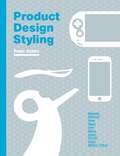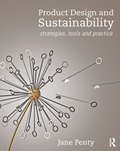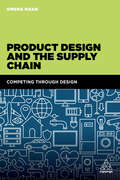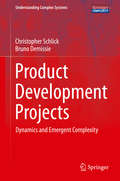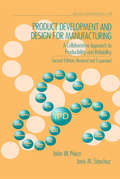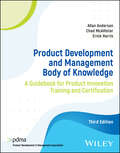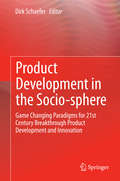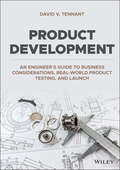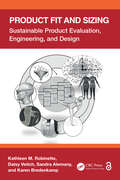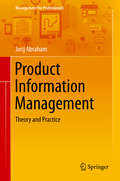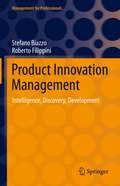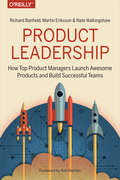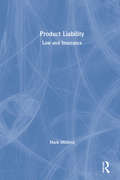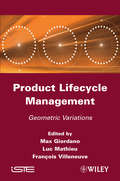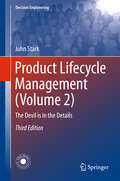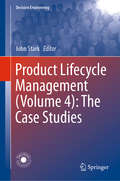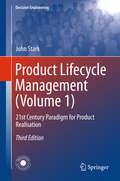- Table View
- List View
Product Design (Portfolio)
by Paul Rodgers Alex MiltonProduct Design offers a broad and comprehensive introduction to the field of product design and the key role of product designers. It follows through all the stages and activities involved in the creation of a new product – from concept design to manufacture, prototyping to marketing. It encourages the reader to challenge conventions and to think about the subject in new and exciting ways.The book also explores the diverse nature of product design, including new and emerging forms of practice. A rich overview of influential design movements and individuals are covered, together with interviews and examples from prominent product designers, and working practices and career guidance relevant to today.Full of visual examples and practical information, the book is an essential guide for students or anyone interested in product design.
Product Design Methods and Practices
by Henry W. Stoll"Focuses on functional, aesthetically pleasing, mechanically reliable, and easily made products that improve profitability for manufacturers and provide long-term satisfaction for customers. Offers concrete, practical insight immediately applicable to new product design and development projects."
Product Design Review: A Methodology for Error-Free Product Development
by Takashi IchidaThe goal of the world class company is to produce a product or service that offers customers the highest quality at the lowest cost and in the shortest time possible. Product Design Review describes a highly effective method for quality control in product design, as well as its applications in a wide variety of business settings. Take care of the problems that erupt during product development by nipping them in the bud (during the design stage). Takashi Ichida describes a powerful tool insuring quality at concept stage, thereby eliminating redesign, retooling, rework, and error throughout the production process. The program he describes can be carried out through every phase of new product development - - from product planning to design, production, and marketing. Also explains how you can incorporate your customer feedback into the next production cycle. You'll always need to modify any process improvement technology to suit your company's culture, product type, manufacturing approach, and customer needs. Product Design Review has taken case studies from a cross section of industries and describes each company's unique application of Ichida's process. You'll not only see the tremendous results these companies have achieved by using Design Review, but you'll also see the difficulties they've encountered. Also included are five essays that compare Design Review with other innovations in manufacturing process such as artificial intelligence, checklists, quality function deployment (QFD), design of experiments (DOE), and configuration control.
Product Design Styling
by Peter DabbsIn this, the first product design book devoted purely to styling, Peter Dabbs helps students and professionals to understand how to style their own consumer-focused products.Providing a clear and simple breakdown of the stages in the styling process, Product Design Styling is packed with:Annotated illustrationsPhotographs of industry examplesModified images showing proportions, silhouettes and linesThe clear text and visual examples guide you through a structured professional styling process that has been broken down into digestible stages. Each stage examines and illustrates what designers should be focusing on, how to evaluate what has been designed, and how to then optimize it if required. You will also learn how to analyse and critique the styling of competitors, as well as your own work, and use this awareness to confidently produce superior designs in less time.
Product Design Styling
by Peter DabbsIn this, the first product design book devoted purely to styling, Peter Dabbs helps students and professionals to understand how to style their own consumer-focused products.Providing a clear and simple breakdown of the stages in the styling process, Product Design Styling is packed with:Annotated illustrationsPhotographs of industry examplesModified images showing proportions, silhouettes and linesThe clear text and visual examples guide you through a structured professional styling process that has been broken down into digestible stages. Each stage examines and illustrates what designers should be focusing on, how to evaluate what has been designed, and how to then optimize it if required. You will also learn how to analyse and critique the styling of competitors, as well as your own work, and use this awareness to confidently produce superior designs in less time.
Product Design and Sustainability: Strategies, Tools and Practice
by Jane PentyWhether it is the effects of climate change, the avalanche of electronic and plastic waste or the substandard living and working conditions of billions of our fellow global citizens, our ability to deal with unsustainability will define the twenty-first century. Given that most consumption is mediated through products and services, the critical question for designers is: How can we radically reshape these into tools for sustainable living? As a guide and reference text, Product Design and Sustainability provides design students, practitioners and educators with the breadth and depth needed to integrate the most appropriate sustainable strategies into their practice. It establishes the principles that underpin sustainability and introduces a diverse range of social, economic and environmental design responses and tools available to designers. The numerous real-world examples illustrate how these strategies play out in different product sectors and reinforce the view that sustainability is the most positive opportunity and creative challenge facing designers today. This book: delivers a comprehensive guide to the principles of sustainability and how they apply to product design that can readily be integrated into curricula and design practice reveals many of the issues specific product sectors are facing, and provides the depth and breadth needed for formulating and developing sustainable design strategies to address these issues empowers and inspires designers to engage with sustainability through its many examples and insightful interviews with practitioners is fully illustrated with over 300 photographs, graphs and diagrams and supported by chapter summaries, annotated further reading suggestions, and a glossary.
Product Design and the Supply Chain: Competing Through Design
by Omera KhanProduct design touches every aspect of modern life, determining the form and function of the products and technologies that we use every day. Product design is not just concerned with the appearance and functionality of products; it has an important role in determining the cost, pricing, risk and profitability profile of those products. Product Design and the Supply Chain shows how decisions taken at the design stage of a product's life cycle go on to affect that product's subsequent value to a company. Eighty percent of a product's eventual supply chain costs are already present at the early stages of product design and development. This book allows companies to make informed design decisions that have significant positive through-life implications for risk, complexity and responsiveness, thus allowing them to create a 'moat' that is difficult for competitors to sidestep or surmount. Product Design and the Supply Chain contains fascinating content applicable to industry. It is full of useful and insightful real-life cases and examples. This book sets out to show how design impacts: sales revenues, pricing, time to market, manufacturing and supply chain costs, supply chain risks, brand loyalty, and competitiveness.
Product Development Fundamentals
by Marco Iansiti Kerry Herman Michael W. Toffel Julia KelleyThis note introduces key managerial issues in new product development. It describes the product development funnel and alternative approaches to structuring product development teams including functional, lightweight, heavyweight, and autonomous/dedicated teams, which vary in their capacity to manage integration. More formal product development approaches including the stage-gate process and critical-path method are described, as are agile methods and principles—and related tools such as scrum, extreme programming, feature-driven development. Product development metrics including lead time, capacity, and productivity are defined and discussed.
Product Development Projects
by Christopher Schlick Bruno DemissieThis book presents an analysis of the dynamics and the complexity of new product development projects which are organized according to the concept of concurrent engineering. The approach of the authors includes both a theoretical and an empirical treatment of the topic, based on the theory of design structure matrices. Readers will discover diverse perspectives and mathematical models, as well as an extensive discussion of two case studies.
Product Development and Design for Manufacturing: A Collaborative Approach to Producibility and Reliability, Second Edition, (Quality and Reliability)
by Jose Sanchez John Priest"Outlines best practices and demonstrates how to desgin in quality for successful development of hardware and software products. Offers systematic applications failored to particular market environments. Discusses Internet issues, electronic commerce, and supply chain."
Product Development and Management Body of Knowledge: A Guidebook for Product Innovation Training and Certification
by Allan Anderson Chad McAllister Ernie HarrisFully-updated Third Edition of the leading study resource for PDMA's New Product Development Professional certification exam The newly revised and updated Third Edition of PDMA Body of Knowledge (BoK) provides a singular reference for anyone currently involved in, or planning a career in product management and product innovation. It describes a proven framework for product innovation which is applicable to a wide cross-section of product and service industries at various levels of an organization. It is also the basis for candidates studying for PDMA's New Product Development Professional (NPDP) certification examination. The guide is divided into seven chapters, consistent with the seven product innovation topics used as a basis for the NPDP examination: management, strategy, portfolio, process, design and development, market research, and culture & teams. PDMA Body of Knowledge includes detailed coverage of topics including: The key factors that lead to successful product innovation management. The importance of strategy to product innovation success, hierarchy of strategies, and establishing the organization's direction via vision, mission, values, and more. The role of portfolio management in selection of the right product innovation projects for an organization. Description of various product innovation processes and the pros and cons of each. The application of tools and techniques at various stages of the design and development process. The application of market research throughout product innovation. The importance of the right culture and team development. The material provided can be applied to the full range of product development projects included in most company portfolios, such as new products or services, line extensions, cost reductions, and product or service improvements. This newly revised and updated Third Edition includes new case studies, examples, and chapter exercises, along with sample NPDP examination questions. PDMA Body of Knowledge is an essential study resource for those studying for PDMA's NPDP exam. The text is also highly valuable to product management professionals, consultants, instructors, and students seeking to increase their knowledge base
Product Development at Dell Computer Corp.
by Stefan Thomke Ashok Nimgade Vish V. KrishnanDescribes how Dell redesigned its new product development process after experiencing a major product setback and a significant decline in firm profits in 1993. Dell's new process is challenged during the development of a new line of portable computers when the incoming head of portables has to manage the risk of using a new technology. This case focuses on: (1) product development process design, (2) the costs and benefits of flexibility and structure in uncertain environments, and, (3) managing development risk during and after a financial and market setback.
Product Development in the Socio-sphere
by Dirk SchaeferThis book provides a broad overview of a number of game-changing paradigms that are anticipated to reshape 21st century product development. Topics including cloud computing-based design, cloud manufacturing, crowd-sourcing and mass collaboration, open source and social product development will be discussed in the context of advanced distributed and collaborative product creation. The purpose of the book is threefold: (1) to provide decision makers in industry with a solid base for strategic design and manufacturing-related process re-organization; (2) to provide researchers and scientist with the state-of-the-art from an academic perspective as well as a research agenda aimed at advancing the theoretical foundations of the field and (3) to serve as supplementary reading in design and manufacturing-related courses at universities and technical colleges.
Product Development: An Engineer's Guide to Business Considerations, Real-World Product Testing, and Launch
by David V. TennantPRODUCT DEVELOPMENT An insightful development roadmap to help engineers and businesspeople successfully bring a product to market In Product Development: An Engineer’s Guide to Business Considerations, Real-World Product Testing, and Launch, accomplished project manager, engineer, and business strategist David V. Tennant delivers a comprehensive walkthrough of the full scope of product development activities, from initial business considerations to real-world product testing and launch. The book covers key product development considerations like determining the target market, working with a product development team, management challenges, funding, user identification, ergonomics, product design, testing, and launch. The distinguished author presents the material in the form of practical, hands-on tutorials with case studies featuring large corporations and small- and mid-size firms. He also includes team exercises and question-and-answer features to help early-career and aspiring engineers acquire the interdisciplinary and inter-department coordination skills they’ll require to successfully bring a new product to market. Readers will learn about the critical roles played by the engineering, marketing, and finance departments, as well as each stage of the product development process. The book also includes: Thorough introductions to product development and the role of the marketing group in product development, including corporate strategy, product and business plans, and marketing leadership Comprehensive explorations of the role of the engineering group in product development, including functional areas led by engineers and engineering leadership Practical discussions of the core team and teamwork in product development, including executives’ roles, the role of the accounting department, and the identification of key stakeholders In-depth examinations of how to move forward with product development after project approval Perfect for early- and mid-career engineers working in product-oriented companies, as well as marketers and other business professionals seeking to understand engineering best practices, Product Development is the ideal reference for use in upper-level undergraduate Product Development courses.
Product Fit and Sizing: Sustainable Product Evaluation, Engineering, and Design
by Kathleen M. Robinette Daisy Veitch Sandra Alemany Karen BredenkampIn this book, for the first time, the complexity of assessing fit and using fittings in the product design process is addressed from a scientific and systems engineering perspective. It includes methods to represent the anthropometry of the target market, good practices to develop protocols for more reliable and consistent fit testing, methods for developing and maintaining a fit database, comprehensive statistical analyses needed for fit and sizing analysis, and instructions for selecting and modeling cases for new product development.Product Fit and Sizing: Sustainable Product Evaluation, Engineering, and Designoffers step-by-step instructions for the evaluation, engineering, and design of existing and new products and includes real-world examples of mass-produced apparel, head wearables, and footwear products. It also explains how to develop a sustainable fit standard for fit and sizing continuity for all styles across all seasons and iterations.This book is intended for industry professionals and undergraduate and graduate education to prepare students for design and engineering jobs. For organizations that purchase uniforms or protective equipment and apparel, it also provides instructions for purchasing professionals to evaluate the suitability of wearable products for their population.The Open Access version of this book, available at http://www.taylorfrancis.com, has been made available under a Creative Commons Attribution-Non Commercial-No Derivatives (CC-BY-NC-ND) 4.0 license.
Product Information Management
by Jorij AbrahamProduct Information Management is the latest topic that companies across the world are deliberating upon. As companies sell online, they are confronted with the fact that not all information necessary to sell their products is available. Where marketing, sales and finance have been core processes of the corporate world for a long time, PIM is a new business process with its own unique implementation and management challenges. The book describes the core PIM processes; their strategic, tactical and operational benefits and implementation challenges. The book has been written for managers, business users as well as students, and illustrates the different concepts with practical cases from companies like Coca Cola, Nikon and Thomas Cook.
Product Innovation Management: Intelligence, Discovery, Development (Management for Professionals)
by Stefano Biazzo Roberto FilippiniThis book offers new insights into the complex set of activities and decisions of product innovation management. It provides concepts, methods, and tools that can help accelerate the introduction of successful products to the market in an increasingly competitive and changing business landscape. It also offers examples and case studies, and it is the result of more than 20 years of study, research, and consulting carried out by the two authors in the field of innovation management. The book discusses the demanding challenges of product innovation and offers practitioners guidance on how to respond to these challenges. It presents a three-level framework (the “innovation pyramid”), which reflects the core components of a firm’s innovation capability: first, intelligence - absorbing information and knowledge from the outside world by looking beyond the familiar territories of the current market, technology, and customers; second, discovery - exploring opportunities for innovation through creative ideation and technology experimentation; and third, development - transforming opportunities into profitable new products and services.
Product Innovation as a Creative Force
by James M. UtterbackThis chapter studies the development of the incandescent electric light and the early lighting industry from the perspective of product innovation, illustrating the successive waves of change that typically occur within an industry over time.
Product Leadership: How Top Product Managers Launch Awesome Products and Build Successful Teams
by Richard Banfield Martin Eriksson Nate WalkingshawIn today’s lightning-fast technology world, good product management is critical to maintaining a competitive advantage. Yet, managing human beings and navigating complex product roadmaps is no easy task, and it’s rare to find a product leader who can steward a digital product from concept to launch without a couple of major hiccups. Why do some product leaders succeed while others don’t?This insightful book presents interviews with nearly 100 leading product managers from all over the world. Authors Richard Banfield, Martin Eriksson, and Nate Walkingshaw draw on decades of experience in product design and development to capture the approaches, styles, insights, and techniques of successful product managers. If you want to understand what drives good product leaders, this book is an irreplaceable resource.In three parts, Product Leadership helps you explore:Themes and patterns of successful teams and their leaders, and ways to attain those characteristicsBest approaches for guiding your product team through the startup, emerging, and enterprise stages of a company’s evolutionStrategies and tactics for working with customers, agencies, partners, and external stakeholders
Product Liability: Law and Insurance
by Mark MildredOriginally published in 2001, Product Liability: Law & Insurance is a highly partical reference work that covers all facets of product liability. It looks at partical applications of the law and gives expert advice on how to operate in given situations; offering guidelines on how to avoid product liability problems and what to do in practice if things do go wrong.
Product Life Cycle
by Noel Capon E. Raymond CoreyIntroduces the student to the concept of the product life cycle. The meaning and fundamental underpinnings of the product life cycle are presented. Further, the nature of market and competitive forces at different stages in the life cycle, and the implications for managerial action, are discussed.
Product Life-Cycle Management: Geometric Variations
by Luc Mathieu François Villeneuve Max GiordanoThis book gives a comprehensive view of the most recent major international research in the field of tolerancing, and is an excellent resource for anyone interested in Computer Aided Tolerating. It is organized into 4 parts. Part 1 focuses on the more general problems of tolerance analysis and synthesis, for tolerancing in mechanical design and manufacturing processes. Part 2 specifically highlights the simulation of assembly with defects, and the influence of tolerances on the quality of the assembly. Part 3 deals with measurement aspects, and quality control throughout the life cycle. Different measurement technologies and methods for estimating uncertainty are considered. In Part 4, different aspects of tolerancing and their interactions are explored, from the definition of functional requirement to measurement processes in a PLM approach.
Product Lifecycle Management
by John StarkProduct Lifecycle Management (2nd edition) explains what Product Lifecycle Management (PLM) is, and why it's needed. It describes the environment in which products are developed, realised and supported, before looking at the basic components of PLM, such as the product, processes, applications, and people. The final part addresses the implementation of PLM, showing the steps of a project or initiative, and typical activities. This new and expanded edition of Product Lifecycle Management is fully updated to reflect the many advances made in PLM since the release of the first edition. It includes descriptions of PLM technologies and examples of implementation projects in industry. Product Lifecycle Management will broaden the reader's understanding of PLM, nurturing the skills needed to implement PLM successfully and to achieve world-class product performance across the lifecycle. "A 20-year veteran of PLM, I highly recommend this book. A clear and complete overview of PLM from definition to implementation. Everything is there - reasons, resources, strategy, implementation and PLM project management." Achim Heilmann, Manager, Global Technical Publications, Varian Medical Systems "Product Lifecycle Management is an important technology for European industry. This state-of-the art book is a reference for those implementing and researching PLM." Dr. Erastos Filos, Head of Sector "Intelligent Manufacturing Systems", European Commission "This book, written by one of the best experts in this field, is an ideal complement for PLM courses at Bachelor and Master level, as well as a well-founded reference book for practitioners." Prof. Dr.-Ing. Dr. h.c. Sandor Vajna, University of Magdeburg, Germany "This comprehensive book can help drive an understanding of PLM at all levels - from CEOs to CIOs, and from professors to students - that will help this important industry continue to expand and thrive." James Heppelmann, President and Chief Executive Officer, PTC "PLM is a mission-critical decision-making system leveraged by the world's most innovative companies to transform their process of innovation on a continuous basis. That is a powerful value proposition in a world where the challenge is to get better products to the market faster than ever before. That is the power of PLM." Tony Affuso, Chairman and CEO, Siemens PLM Software
Product Lifecycle Management (Decision Engineering)
by John StarkThis book presents some twenty case studies, showing how companies in different industry sectors and of different sizes make advances in Product Lifecycle Management (PLM). Like the author’s previous volumes, this book provides a valuable resource for those wishing to learn about PLM and how to implement and apply it in their companies. Helping readers to · learn about implementing and benefiting from PLM;· learn about good PLM solutions and best practice;· improve their planning and decision-making abilities;· benefit from the lessons learned by the companies featured in the case studies; · proceed faster and further with PLM the book presents effective PLM solutions and best practices. At the same time, the case studies included demonstrate how different companies implement and benefit from PLM. Each case study is addressed in a separate chapter and details a different situation, enabling readers to put themselves in the situation and think through different actions and decisions. A valuable resource for PLM team managers and employees in engineering and manufacturing companies, the book is also of interest to researchers and students in industrial engineering fields.
Product Lifecycle Management (Volume #1)
by John StarkThis third edition updates and adds to the successful second edition and gives the reader a thorough description of PLM, providing them with a full understanding of the theory and the practical skills to implement PLM within their own business environment. This new and expanded edition is fully updated to reflect the many technological and management advances made in PLM since the release of the second edition. Describing the environment in which products are developed, manufactured and supported, before addressing the Five Pillars of PLM: business processes, product data, PLM applications, Organisational Change Management (OCM) and Project Management, this book explains what Product Lifecycle Management is, and why it's needed. The final part of the book addresses the PLM timeline, showing the typical steps and activities of a PLM project or initiative. "Product Lifecycle Management" will broaden the reader's understanding of PLM, nurturing the skills needed to implement PLM successfully and to achieve world-class product performance across the lifecycle.
